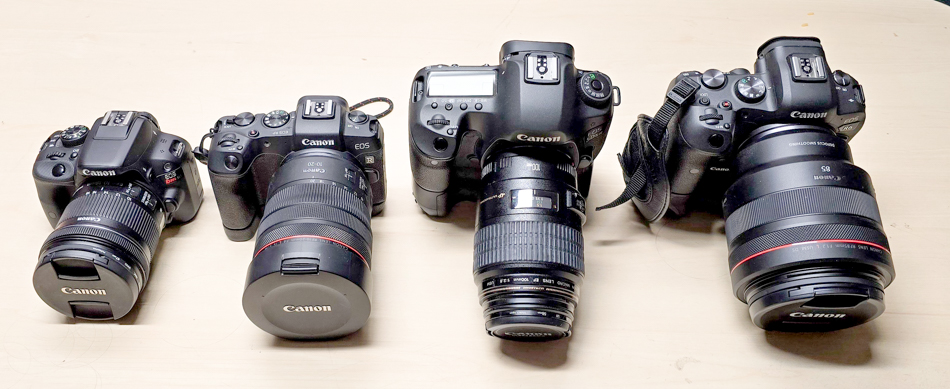
Pictured above are seven different cameras.
Across the back left to right: Canon A2e (35mm film), Canon 5D Mark II (full-frame digital), Canon Rebel XTi (1.6x digital), Crown Graphic View Camera (4x5 film)
Across the front left to right: Canon SD 1400 IS (point-and-shoot), Canon G11 ('advanced' point-and-shoot), and GoPro HERO2 HD (sports action camera)
Photography should always be about the end product not the cameras themselves, but nevertheless the camera that you choose to use is important. I've included the photo above of a variety of cameras to illustrate some of the different sizes and shapes that cameras have and continue to come in: all of these camera types are still available today.
The oldest camera above - in the far right of the back row - is a view camera which shoots on 4 inch by 5 inch sheets of film: 4x5 is still commonly used in certain professional fields of photography and is readily available. This type of camera is called a 'direct view' camera, or simply a view camera: this is because the image is viewed directly through the lens via ground glass. Once you've focused the image on the ground glass through the open shutter, the shutter is closed, a film cartridge is slid in in front of the ground glass, the slide is pulled out from in front of the film, and the shutter is released. Even small 4x5 cameras are bulky to carry around, but they offer quality unmatched by any other photographic medium (8x10 is also a common size sheet film for view cameras). As the image is viewed directly through the lens to the ground glass, the image in the ground glass is upside-down and backwards, which takes some getting used to. 4x5 cameras today are only used for subjects that are still: landscapes, product shoots, etc.
The three cameras to the left of the 4x5 in the back row are all SLRs - Single Lens Reflex. It's called a 'single lens' reflex, because the camera only has one lens. (Twin Lens Reflex cameras do exist but are not very common today: the top lens is used as the viewfinder, and the lower lens exposes the film/sensor. The lens is shared on an SLR.) The 'reflex' in SLR is because you're looking through the camera's lens via a reflex mirror that runs the image through a prism so that we see the image in the viewfinder right side up. When the shutter of an SLR is fired, the mirror flips up to allow the image to go back to either film or the digital sensor on the camera. The 'D' in DSLR simply stands for "Digital" SLR: SLRs that use a digital sensor instead of 35mm film. An SLR's main advantage is its speed: when you press the shutter it fires instantaneously. Additionally, all modern SLRs have quick auto-focus, and mirrorless are even faster with more AF points by far.
The three cameras in front are all variations on point-and-shoot cameras. A point-and-shoot camera is a camera with a fixed lens (often a zoom lens: fixed as in not removable from the camera) and very basic adjustments: you pretty much just "point" then "shoot." Many point and shoots do not have a viewfinder: you simply use the screen on the back to compose your photo. When you go to hit the shutter there is always a slight delay before the shot is taken, which makes point-and-shoots often less than ideal for anything involving any kind of motion. Some more advanced point-and-shoots like the G11 pictured above will allow for user control identical to a SLR, but this delay still separates them out from true SLRland.
Why Shoot Mirrorless (or DSLR)?
Don't bother purchasing a mirrorless unless you're really going to take advantage of it. The cameras in iPhones, and Android Devices take excellent photos and offer crazy lens options. If you're into basic, simple, and light, stick with your phone's camera or a point-and-shoot which does most of the work for you.
The following are the reasons to shoot a Mirrorless:
- Instantaneous shutter response
- Faster autofocus
- Greater creative control
- Greater depth-of-field (selective focus)
- Larger sensors than most point-and-shoots
- Much better low-light performance
- Nearly unlimited lens options (particularly with Canon, Nikon, Sony)
- A must for any sort of action photography, from professional sports to your kid running across the room
Holding a mirrorless or DSLR camera for the first time may feel intimidating, but relax: they're a lot more simple to use than they might seem and after you learn a handful of basics (the point of this blog) you'll find that you feel much more at ease and that you're able to photograph in ways that you've never been able to before.

















